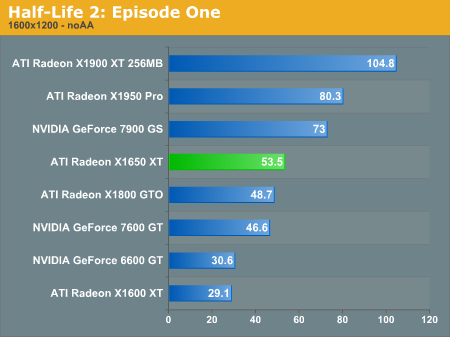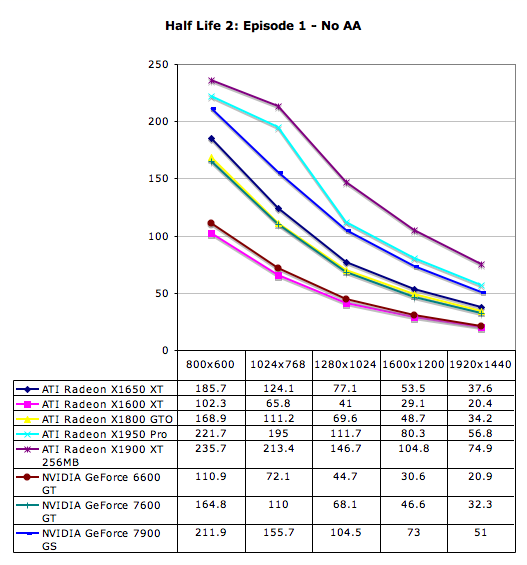Introducing the Radeon X1650 XT: A New Mainstream GPU from ATI
by Josh Venning on October 30, 2006 6:00 AM EST- Posted in
- GPUs
Half-Life 2: Episode One Performance
Half-Life 2: Episode One is the most recent episode of Valve's continuation of the Half-Life 2 storyline. This saga stands out to us as having the most interesting storyline of just about any game, and also having the most interesting characters (with possibly the best voice acting of any game). Not only does Episode One expand on Half-Life 2 with more original gameplay elements, but the developers also gave the game a graphical upgrade with this installment. HDR and bloom effects were added that give the engine a needed face-lift, while keeping the subtlety of the Source engine. We're very anxiously awaiting the release of Episode Two to see what direction Valve takes this game next.
To test this game, we use the built in timedemo feature. Our test consists of a section of the game during a rocket launcher battle against a Combine gunship, with lots of explosions and boards exploding into shards, making good use of Half-Life 2's Havok physics engine. We test this game with the quality settings to "high" when possible, with "reflect all" chosen which usually isn't on by default. We also set anisotropic filtering to 8x. We look for an average frame rate of about 30 or higher in order to get an enjoyable experience.


The original Half-Life 2 engine broke a lot of ground in its design, and it still shapes the way games are made today. One of the great things about the Half-Life 2 engine was that even though it looked great, it still got very good frame rates across a very wide range of cards, even on the lower end. The newer features of the Episode One engine have given the game a bit more of a performance hit, but it still gets better frame rates than many competing games.
Half-Life 2: Episode One is the most recent episode of Valve's continuation of the Half-Life 2 storyline. This saga stands out to us as having the most interesting storyline of just about any game, and also having the most interesting characters (with possibly the best voice acting of any game). Not only does Episode One expand on Half-Life 2 with more original gameplay elements, but the developers also gave the game a graphical upgrade with this installment. HDR and bloom effects were added that give the engine a needed face-lift, while keeping the subtlety of the Source engine. We're very anxiously awaiting the release of Episode Two to see what direction Valve takes this game next.
To test this game, we use the built in timedemo feature. Our test consists of a section of the game during a rocket launcher battle against a Combine gunship, with lots of explosions and boards exploding into shards, making good use of Half-Life 2's Havok physics engine. We test this game with the quality settings to "high" when possible, with "reflect all" chosen which usually isn't on by default. We also set anisotropic filtering to 8x. We look for an average frame rate of about 30 or higher in order to get an enjoyable experience.


The original Half-Life 2 engine broke a lot of ground in its design, and it still shapes the way games are made today. One of the great things about the Half-Life 2 engine was that even though it looked great, it still got very good frame rates across a very wide range of cards, even on the lower end. The newer features of the Episode One engine have given the game a bit more of a performance hit, but it still gets better frame rates than many competing games.










33 Comments
View All Comments
Lonyo - Monday, October 30, 2006 - link
The X1950Pro can also be had in the US for $200 now from various websites, even if the prices at the top of this article show otherwise.Lonyo - Monday, October 30, 2006 - link
http://www.newegg.com/Product/Product.asp?Item=N82...">Sapphire X1950 Pro - in stock - $199
http://www.zipzoomfly.com/jsp/ProductDetail.jsp?Pr...">Sapphire X1950 In stock $205
Then there are 3 OOS at ZZF for $199.
http://www.amazon.com/Express-Radeon-X1950PRO-256-...">$188 from Amazon, apparently
DerekWilson - Monday, October 30, 2006 - link
tweaked that sentence to reflect current pricing.